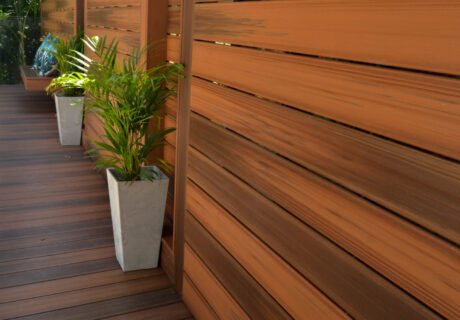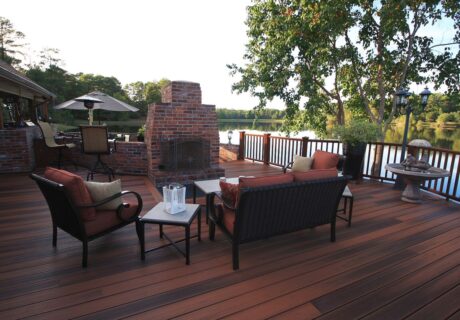Each season it seems like a new decking product or outdoor dining and entertaining option is introduced that helps homeowners transform their plain old deck into a personal outdoor oasis. Aside from all the new innovations and options available for building a new deck, some of the most important decisions still comes down to selecting the best decking materials.
There are three primary types of decking materials, each with their own pros and cons:
- Composite decking
- Pressure-treated (PT) wood
- Plastic polyvinyl chloride (PVC) decking
Deciding which material is best depends on a number of factors that are specific to each homeowner’s unique situation. While the factors themselves are pretty common – aesthetics, cost, convenience and performance – the value each family places on each consideration will vary from one household to another.
Here are a few things to consider as you select a material for your new or remodeled deck.
Wood Decking Materials Offer Speed and Convenience
Historically, because of its widespread availability, low cost and adequate performance, the vast majority of residential decks have been built using pressure treated (PT) lumber – typically pine. Additionally, PT lumber can be painted or stained to virtually any color, making it a logical choice for homeowners that have a very specific color scheme in mind.
The downside of PT lumber is that even when treated, it absorbs moisture and will eventually splinter and rot over time. In order to prolong the life of PT lumber, significant maintenance (sanding and staining or painting) is required annually. Wood decking that is not properly maintained can introduce safety issues as well, from simple splinters to deck collapse due to rot.
PVC Decking Material Will Not Rot and Offers a Long-Term Option
Over the past two decades, the emergence of non-wood building materials have given home and deck builders the freedom to construct beautiful exterior elements in environments where traditional lumber would rapidly deteriorate. Plastic polyvinyl chloride (PVC) material became popular largely because of how easy it is to clean and its resistance to stains. It’s enhanced resistance to mold and mildew growth – having no organic material to attach itself to – also make it a popular choice, particularly in marine environments where moisture is abundant and sunlight scarce.
That said, while PVC does provide moisture resistance, it is also more susceptible to cracking and splitting – especially when exposed to cold temperatures. It’s typically more expensive than other materials as well. While cracking and splitting may be less of an issue for PVC materials attached to solid, immobile home exteriors (for example, non-load bearing trim boards or clapboard sheathing) this rigidity can be problematic when attached to framing and supports made of traditional PT lumber.
When selecting a PVC decking material, consumers should make a point to ask the contractor to provide a sample of the actual product. Not all products are made the same way and appearances can vary from one product to the next. Also, since PVC decking does tend to flex and sag more than traditional lumber (and wood composite decking) it will require additional framing support.
Another concern that some homeowners may have with building a new deck with PVC decking is adding more plastic into an already substantial waste stream. With an average useful lifespan of 30 years, many PVC products that were initially introduced in the 1980s are now being replaced and disposed of in landfills. Because of its high levels of chlorine – which gives PVC its higher mold and mildew resistance – recycling PVC products is a cumbersome process.
Composite Decking Provides Best Long-Term Value and Performance
A relatively new alternative to building an “all wood” or “all plastic” deck can provide homeowners with the best of both worlds. Polypropylene-based composite decking, including the Barrette Outdoor Living Decking offers high-quality composite decking products that are made from a combination of reclaimed plastic and wood fibers.
The strength of composite decking comes from the natural wood fibers embedded within the product, allowing it to be installed over existing PT wood framing. Along with its superior resistance to mold and mildew growth, composite decking will never crack or splinter, making it more comfortable underfoot — even in bare feet. Unlike some PVC decking products that can become slippery when wet, Barrette Outdoor Living Decking is made with a deep, embossed wood grain combined with a co-extruded surface that provides superior traction even when wet.
Another important benefit of composite decking is that it is made up of up to 90% post-industrial and post-consumer waste, reducing its environmental impact. And unlike PT wood that must be regularly cleaned with harsh chemicals before repainting, capped composite decks only require occasional washing with soap and water. Backed by Barrette Outdoor Living’s Transferable Limited Warranty, this high-quality composite deck choice can easily last 25+ years and still look and feel great.
See and feel the difference yourself. Order your samples of Barrette Outdoor Living Decking now and have them shipped directly to your door!




